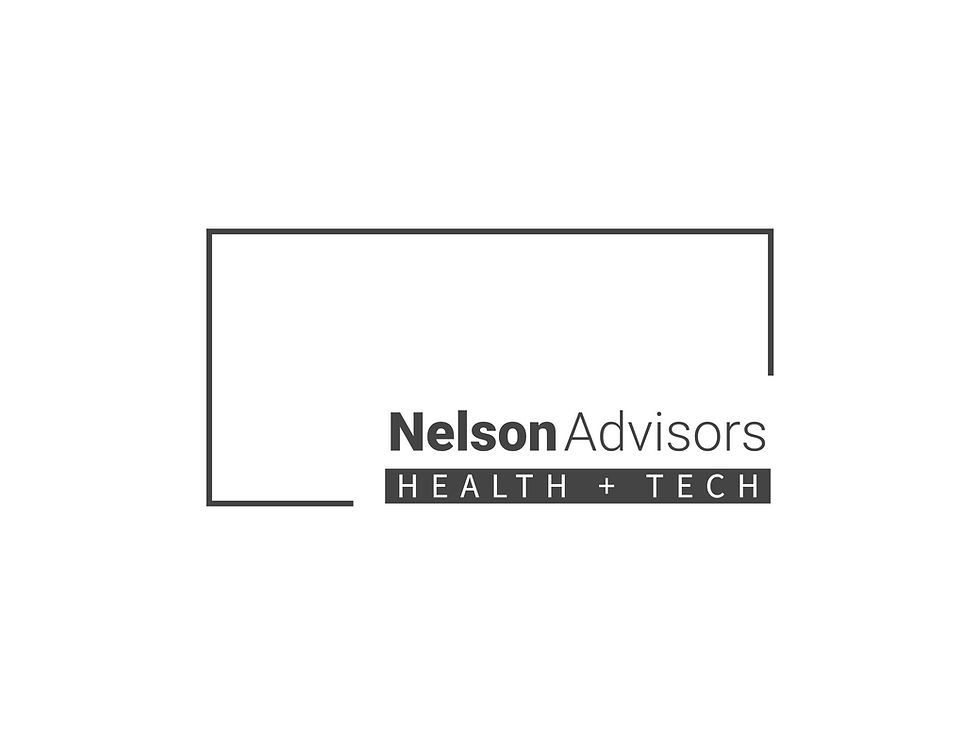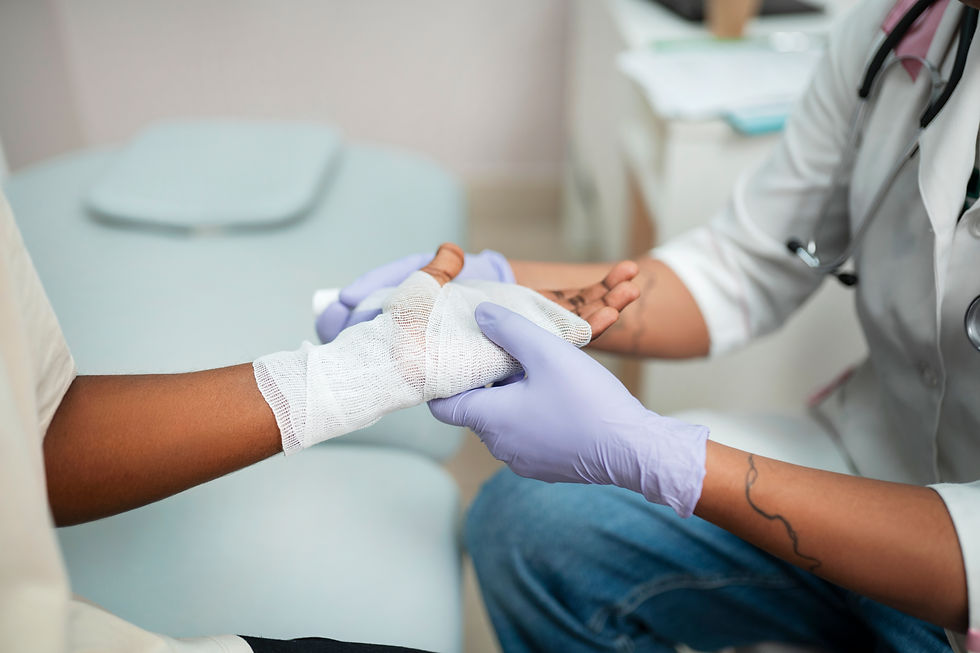Wound Care: Emerging HealthTech market to watch in 2025
- Lloyd Price
- Dec 2, 2024
- 8 min read

Exec Summary:
The wound care market is a rapidly growing market, with a projected value of $27.2 billion by 2027. This growth is being driven by a number of factors, including the increasing prevalence of chronic wounds, the aging population, and technological advances in wound care.
Some of the emerging technologies in wound care include:
Nanotechnology: Nanotechnology is being used to develop new wound dressings that can deliver drugs and other therapies directly to the wound site.
Stem cell therapy: Stem cell therapy is being investigated as a potential treatment for chronic wounds. Stem cells have the ability to differentiate into different types of cells, including skin cells, which could help to regenerate damaged tissue.
Bioengineered skin grafts: Bioengineered skin grafts are being developed that can be used to replace damaged skin. These grafts are made from a patient's own cells, which reduces the risk of rejection.
3D printing: 3D printing is being used to create customised wound dressings that fit the specific needs of each patient.
The wound care market is a dynamic and rapidly evolving sector, and 2025 is shaping up to be a pivotal year for innovation and growth in this field. Here are some key trends and developments to watch:
Key Trends:
Technological Advancements: New technologies are revolutionizing wound care, including advanced wound dressings, bioengineered skin substitutes, and innovative wound management devices. These innovations are improving wound healing, reducing infection rates, and enhancing patient comfort.
Digital Health Solutions: Digital health solutions are gaining traction in wound care, enabling remote monitoring, telemedicine consultations, and data-driven decision-making. This shift towards digitalisation is improving patient outcomes and reducing healthcare costs.
Personalised Medicine: Personalised medicine approaches are emerging in wound care, allowing for tailored treatment plans based on individual patient needs and genetic factors. This personalized approach enhances treatment efficacy and accelerates healing.
Focus on Chronic Wounds: Chronic wounds, such as diabetic ulcers and pressure ulcers, remain a significant healthcare challenge. The increasing prevalence of these conditions is driving demand for innovative solutions and improved management strategies.
Aging Population: The aging population is contributing to the growth of the wound care market, as older adults are more susceptible to chronic wounds and require specialised care.
Rising Healthcare Costs: Rising healthcare costs are driving the need for cost-effective wound care solutions. Innovative technologies and digital health solutions can help reduce costs and improve efficiency.
Emerging Technologies to Watch:
3D Bioprinting: 3D bioprinting technology is enabling the creation of bioengineered skin substitutes and other tissue constructs for wound healing.
Artificial Intelligence (AI): AI-powered tools are being used to analyse wound images, predict healing outcomes, and optimise treatment plans.
Internet of Things (IoT): IoT devices are being used to monitor wound healing remotely, enabling timely interventions and reducing the need for frequent clinic visits.
Wearable Sensors: Wearable sensors can track various vital signs and wound parameters, providing real-time data for personalised care.
Challenges and Opportunities:
Regulatory Hurdles: Navigating regulatory hurdles can be challenging for innovative wound care products and technologies.
Healthcare Professional Education: Ensuring healthcare professionals are adequately trained in the use of new technologies and treatment modalities is crucial.
Patient Education: Educating patients about wound care and self-management is essential to improve outcomes.
The wound care market is poised for significant growth in 2025 and beyond. By embracing technological advancements, focusing on personalised medicine, and addressing the challenges of chronic wounds, the industry can improve patient outcomes, reduce costs, and enhance the overall quality of care.
Nelson Advisors work with Healthcare Technology Founders, Owners and Investors to assess whether they should 'Build, Buy, Partner or Sell' in order to maximise shareholder value.
Healthcare Technology Thought Leadership from Nelson Advisors – Market Insights, Analysis & Predictions. Visit https://www.healthcare.digital
HealthTech Corporate Development - Buy Side, Sell Side, Growth & Strategy services for Founders, Owners and Investors. Email lloyd@nelsonadvisors.co.uk
HealthTech M&A Newsletter from Nelson Advisors - HealthTech, Health IT, Digital Health Insights and Analysis. Subscribe Today! https://lnkd.in/e5hTp_xb
HealthTech Corporate Development and M&A - Buy Side, Sell Side, Growth & Strategy services for companies in Europe, Middle East and Africa. Visit www.nelsonadvisors.co.uk

Venture Capital investment into Wound Care
Venture capital (VC) investment in the wound care market has been steadily increasing in recent years, driven by several factors:
Market Trends Driving VC Investment:
Aging Population: The global aging population is leading to a rise in chronic wounds, such as diabetic ulcers and pressure ulcers.
Technological Advancements: New technologies, including advanced wound dressings, bioengineered skin substitutes, and digital health solutions, are revolutionising wound care.
Rising Healthcare Costs: The increasing cost of healthcare is driving the need for cost-effective wound care solutions.
Improved Patient Outcomes: Innovative wound care products and technologies are improving patient outcomes, reducing healing times, and minimising complications.
Specific Areas of VC Interest:
Advanced Wound Dressings: VCs are investing in companies developing innovative wound dressings with advanced properties, such as antimicrobial, moisture-wicking, and biocompatible materials.
Regenerative Medicine: Companies focused on regenerative medicine and tissue engineering are attracting significant VC investment, as these technologies hold the potential to revolutionise wound healing.
Digital Health Solutions: VCs are investing in digital health companies developing mobile apps, telemedicine platforms, and AI-powered tools to improve wound care management.
Point-of-Care Diagnostics: Companies developing point-of-care diagnostic tests to assess wound severity and monitor healing progress are also attracting VC interest.
Recent Examples of VC Investment in Wound Care:
Corryn Biotechnologies: This UK-based startup raised £550,000 in seed funding to develop a novel wound dressing technology.
Neoplas Med: This German medical technology company received an additional $18 million in funding from Niterra Ventures Company to expand its market for innovative wound care technology products.
SolasCure: This UK-based biotech company raised £15 million to develop a wound cleaning product based on an enzyme cloned from medical maggots.
Pixacare: This French startup raised €3 million to automate wound care monitoring using AI-powered technology.
Challenges and Opportunities:
While the wound care market offers significant opportunities for VC investment, there are also challenges to consider:
Regulatory Hurdles: Navigating regulatory hurdles can be time-consuming and costly, particularly for medical device and drug development.
Clinical Trials: Conducting clinical trials to demonstrate the safety and efficacy of new wound care products and technologies can be expensive and time-consuming.
Reimbursement Challenges: Securing reimbursement from healthcare payers can be challenging, particularly for innovative technologies that may not be covered by traditional reimbursement codes.
Despite these challenges, the wound care market remains an attractive investment opportunity for VCs due to its growing market size, technological advancements, and potential for significant impact on patient outcomes.

Wound Care set to be a $27.2 billion market by 2027
The wound care market is a rapidly growing market, with a projected value of $27.2 billion by 2027. This growth is being driven by a number of factors, including the increasing prevalence of chronic wounds, the aging population, and technological advances in wound care.
Some of the emerging technologies in wound care include:
Nanotechnology: Nanotechnology is being used to develop new wound dressings that can deliver drugs and other therapies directly to the wound site.
Stem cell therapy: Stem cell therapy is being investigated as a potential treatment for chronic wounds. Stem cells have the ability to differentiate into different types of cells, including skin cells, which could help to regenerate damaged tissue.
Bioengineered skin grafts: Bioengineered skin grafts are being developed that can be used to replace damaged skin. These grafts are made from a patient's own cells, which reduces the risk of rejection.
3D printing: 3D printing is being used to create customised wound dressings that fit the specific needs of each patient.
These are just a few of the emerging technologies in wound care. As these technologies continue to develop, they have the potential to revolutionize the way that wounds are treated.
Here are some additional details about each of these emerging technologies:
Nanotechnology: Nanotechnology is the use of materials and devices at the nanoscale (1-100 nanometers). Nanoparticles can be used to deliver drugs and other therapies directly to the wound site. This can be beneficial because it can help to increase the effectiveness of the therapy and reduce the side effects. Nanoparticles can also be used to create wound dressings that are more absorbent and resistant to infection.
Stem cell therapy: Stem cells are undifferentiated cells that have the potential to develop into different types of cells. Stem cells can be used to regenerate damaged tissue, including skin tissue. Stem cell therapy is still in its early stages, but it has the potential to be a very effective treatment for chronic wounds.
Bioengineered skin grafts: Bioengineered skin grafts are made from a patient's own cells. These grafts are grown in the lab and then transplanted onto the patient's wound. Bioengineered skin grafts are more likely to be accepted by the patient's body than traditional skin grafts.
3D printing: 3D printing is a process that can be used to create three-dimensional objects from a digital file. 3D printing is being used to create customized wound dressings that fit the specific needs of each patient. These dressings can be designed to provide the optimal level of protection, absorption, and moisture control

Future of Wound Care
The future of wound care is brimming with exciting innovations that promise to revolutionise the way we treat wounds. Here are some key trends shaping the future of wound care:
1. Advanced Wound Dressings:
Smart Dressings: These dressings are equipped with sensors that monitor wound healing progress, temperature, and moisture levels, providing real-time data to healthcare providers.
Bioactive Dressings: These dressings release growth factors and other bioactive agents to stimulate tissue regeneration and reduce inflammation.
3D-Printed Dressings: Customised dressings can be 3D printed to fit specific wound shapes and sizes, optimising healing and reducing the risk of infection.
2. Regenerative Medicine:
Stem Cell Therapy: Stem cells can be used to regenerate damaged tissues, accelerating wound healing and reducing scarring.
Tissue Engineering: Engineered tissues can be created to replace damaged skin and other tissues, offering a more permanent solution for complex wounds.
3. Digital Health Solutions:
Telehealth: Remote monitoring of wounds using telemedicine allows for timely interventions and reduces the need for frequent clinic visits.
AI-Powered Wound Assessment: Artificial intelligence can analyse wound images to assess healing progress, identify potential complications, and optimise treatment plans.
Wearable Devices: Wearable sensors can track vital signs and wound parameters, providing real-time data for personalised care.
4. Personalised Medicine:
Genetic Testing: Genetic testing can identify individual variations that may affect wound healing, allowing for tailored treatment plans.
Precision Medicine: By analysing a patient's specific genetic makeup, medical history, and lifestyle factors, healthcare providers can develop personalised treatment strategies.
5. Natural-Based Therapies:
Honey: Honey has antimicrobial properties and can promote wound healing.
Plant-Based Extracts: Extracts from various plants, such as aloe vera and chamomile, have been shown to have wound-healing properties.
While these innovations hold immense promise, several challenges must be addressed to fully realise their potential:
Regulatory Hurdles: Navigating regulatory processes for new medical devices and therapies can be time-consuming and costly.
Healthcare Professional Education: Ensuring healthcare professionals are adequately trained in the use of new technologies and treatment modalities is crucial.
Patient Education: Educating patients about wound care and self-management is essential to improve outcomes.
Access and Affordability: Ensuring that these innovative treatments are accessible and affordable to all patients is a major challenge.
By overcoming these challenges and embracing these exciting advancements, the future of wound care promises to be a brighter one, with improved patient outcomes and reduced healthcare costs.
Nelson Advisors work with Healthcare Technology Founders, Owners and Investors to assess whether they should 'Build, Buy, Partner or Sell' in order to maximise shareholder value.
Healthcare Technology Thought Leadership from Nelson Advisors – Market Insights, Analysis & Predictions. Visit https://www.healthcare.digital
HealthTech Corporate Development - Buy Side, Sell Side, Growth & Strategy services for Founders, Owners and Investors. Email lloyd@nelsonadvisors.co.uk
HealthTech M&A Newsletter from Nelson Advisors - HealthTech, Health IT, Digital Health Insights and Analysis. Subscribe Today! https://lnkd.in/e5hTp_xb
HealthTech Corporate Development and M&A - Buy Side, Sell Side, Growth & Strategy services for companies in Europe, Middle East and Africa. Visit www.nelsonadvisors.co.uk


















































Comentarios